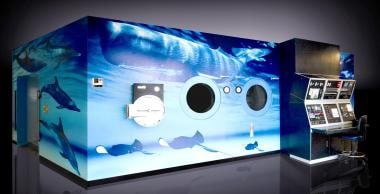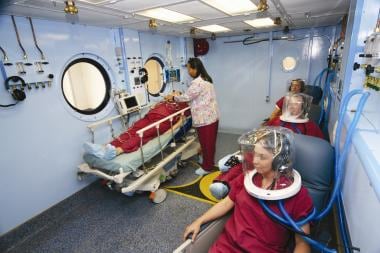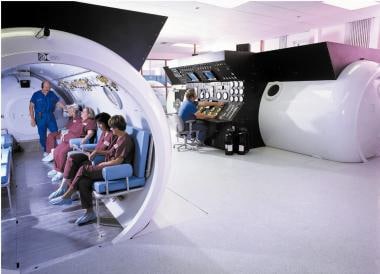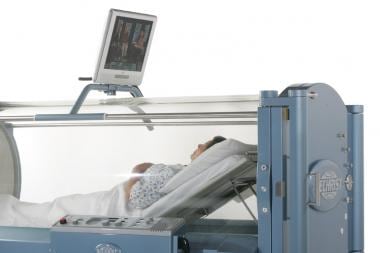Hyperbaric Oxygen Therapy
8/19/2015, Emi Latham, MD, FACEP, FAAEM; Michael Neumeister, MD, FRCSC, FACS; Marc Hare, MD;
Overview
Hyperbaric oxygen therapy (HBOT) is breathing 100% oxygen while under increased atmospheric pressure. HBOT is a treatment that can be traced back to the 1600s. The first well-known chamber was built and run by a British clergyman named Henshaw. He built a structure called the domicilium that was used to treat a multitude of diseases.[1] The chamber was pressurized with air or unpressurized using bellows. The idea of treating patients under increased pressure was continued by the French surgeon Fontaine, who built a pressurized, mobile operating room in 1879.[2] Dr. Orville Cunningham, a professor of anesthesia, ran what was known as the "Steel Ball Hospital." The structure, erected in 1928, was 6 stories high and 64 feet in diameter. The hospital could reach 3 atmospheres of pressure.[2] The hospital was closed in 1930 because of the lack of scientific evidence indicating that such treatment alleviated disease. It was deconstructed during World War II for scrap.
The military continued work with hyperbaric oxygen. The work of Paul Bert, who demonstrated the toxic effects of oxygen (producing grand mal seizures), as well as the work of J. Lorrain-Smith, who demonstrated pulmonary oxygen toxicity, were used with Navy divers. Exposure times to oxygen at different depths of water (and, hence, different levels of pressure) were quantified and tested based on time to convulsions.[2]
Oxygen Chambers
When a patient is given 100% oxygen under pressure, hemoglobin is saturated, but the blood can be hyperoxygenated by dissolving oxygen within the plasma. The patient can be administered systemic oxygen via two basic chambers: Type A, multiplace; and Type B, monoplace. Both types can be used for routine wound care, treatment of most dive injuries, and treatment of patients who are ventilated or in critical care.
Multiplace chamber
Multiplace chambers treat multiple patients at the same time, generally with a nurse or another inside observer who monitors the patients and assists with equipment manipulation or emergencies (see images below). Patients in a multiplace chamber breathe 100% oxygen via a mask or close-fitting plastic hood. Multiplace chambers can usually be pressurized to the equivalent of about six atmospheres of pressure.
If a different mixture of gas (nitrogen or helium mixture) is desired, the mixture can be given, via the mask, to only the patient, not the employee. All equipment used with patients, such as ventilators and intravenous lines, is put into the chamber with the patient. Since the employee is breathing air during the treatment (not using a mask), his or her nitrogen intake must be monitored, as this presents a risk for problems similar to those sometimes developed by scuba divers (eg,decompression sickness [DCS]).
 Rectangular hyperbaric chamber.
Rectangular hyperbaric chamber.
 Interior of rectangular chamber.
Interior of rectangular chamber.
 Cylindrical multiplace chamber.
Cylindrical multiplace chamber.
Monoplace chamber
A monoplace chamber compresses one person at a time, usually in a reclining position (see image below). The gas used to pressurize the vessel is usually 100% oxygen. Some chambers have masks available to provide an alternate breathing gas (such as air). Employees tend to the patient from outside of the chamber and equipment remains outside the chamber. Only certain intravenous lines and ventilation ducts penetrate through the hull. Newer Duoplace chambers can hold two people. Their operation is similar to that of a monoplace chamber.
 Monoplace chamber.
Monoplace chamber.
Other chambers
Two other types of chambers are worth mentioning, although they are notconsidered HBOT.
Topical oxygen, or Topox, is administered through a small chamber that is placed over an extremity and pressurized with oxygen. The patient does not breathe the oxygen, nor is the remainder of the body pressurized. Therefore, the patient cannot benefit from most of the positive effects of HBOT, which are systemic or occur at a level deeper than topical oxygen can penetrate (see Hyperbaric Physics and Physiology section below). Topox is based on the concept that oxygen diffuses through tissue at a depth of 30-50 microns.[3] This method does not treat DCS, arterial gas emboli (AGE), or carbon monoxide (CO) poisoning.
Another problem with Topox is the design of the unit. A pressure differential must be created between the machine and open atmosphere to compress the machine. In order to keep the extremity from being pushed out of the pressurized machine, the cuff of the box must fit very tightly around the extremity, thereby creating a tourniquetlike effect. Topox is not covered by insurance, nor is it endorsed by the journal Diabetes Care for the treatment of foot ulcers.[4]
The other type of chamber is the portable "mild" hyperbaric chamber. These soft vessels can be pressurized to 1.5-1.7 atmospheres absolute (ATA). They are only approved by the FDA for the treatment of altitude illness. The number of these chambers has increased, as they are being used more commonly in off-label indications.
To continue reading this article as it was originally posted on Medscape, please click here.